
The aye-aye is a long-fingered lemur, a strepsirrhine primate native to Madagascar with rodent-like teeth that perpetually grow and a special thin middle finger that they can use to catch grubs and larvae out of tree trunks.

Nepenthes madagascariensis is one of two Nepenthes pitcher plant species native to Madagascar, the other being N. masoalensis.
Kaliphora madagascarensis is a species of evergreen shrub or small tree. It is endemic to Madagascar, where it inhabits subhumid woodlands and forests in eastern Madagascar, in the provinces of Antananarivo, Antsiranana, Fianarantsoa, and Mahajanga.
Podocarpus madagascariensis is a species of conifer in the family Podocarpaceae. It is found only in Madagascar.
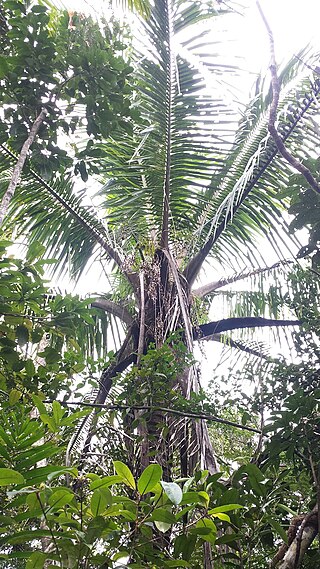
Voanioala gerardii, commonly known as the forest coconut, is a species of flowering plant in the family Arecaceae. It is a relative of the coconut, and is generally regarded as monotypic within the genus Voanioala. However, a team of geneticists headed by Bee F. Gunn found sufficient genetic variation within Voanioala to constitute at least two and possibly four cryptospecies. Voanioala is endemic to Madagascar, and is threatened by habitat loss. Voanioala is harvested for its edible seeds and palm heart. It is estimated that there are fewer than 15 mature trees remaining.
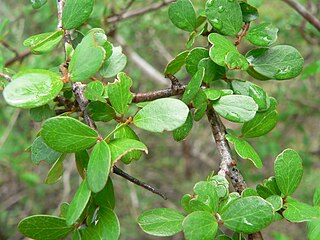
Khaya madagascariensis is a species of plant in the family Meliaceae. It is found in Comoros and Madagascar.

Bismarckia is a monotypic genus of flowering plant in the palm family endemic to western and northern Madagascar, where it grows in open grassland.
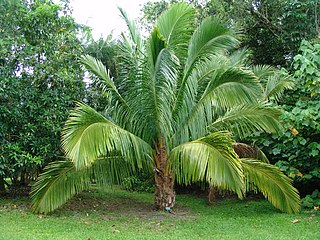
Beccariophoenix madagascariensis, commonly known as the coastal beccariophoenix, is a species of flowering plant in the family Arecaceae. It is a large Coconut relative that is vulnerable in its habitat in Madagascar.

Tsimanampetsotsa National Park also spelt Tsimanampetsotse, and known as Tsimanampetsotsa Nature Reserve is a 432 km2 national park on the south-west coast of Madagascar in the region Atsimo-Andrefana. The park is 90 kilometres (56 mi) south of Toliara and 950 kilometres (590 mi) south of the capital, Antananarivo. Route Nationales (RN) 10 to Faux Cap passes the park and the nearest airport is at Toliara. The national park contains and is named after Lake Tsimanampetsotsa.
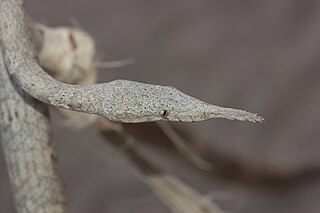
Langaha madagascariensis is a medium-sized highly cryptic arboreal species. It is endemic to Madagascar and found in deciduous dry forests and rain forests, often in vegetation 1.5 to 2 meters above the ground.

Ravenala madagascariensis, commonly known as the traveller's tree, traveller's palm or East-West palm, is a species of monocotyledonous flowering plant found in Madagascar. It is not a true palm but a member of the family Strelitziaceae.
Celtis madagascariensis is a species of flowering plant endemic to Madagascar.
Chapelieria is a monotypic genus of flowering plants in the family Rubiaceae. The genus contains only one species, viz. Chapelieria madagascariensis, which is endemic to Madagascar.
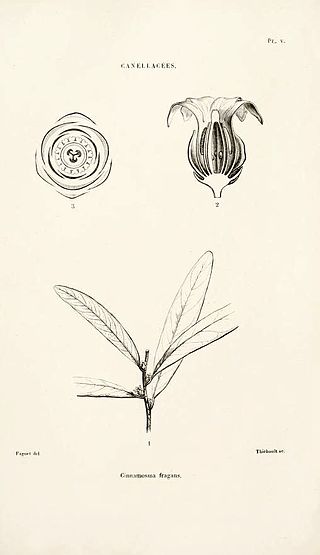
Cinnamosma fragrans is a species of flowering plant in the family Canellaceae. It is endemic to Madagascar, where it is commonly known as saro.
Cinnamosma macrocarpa is a species of flowering plant in the family Canellaceae. It is endemic to Madagascar.
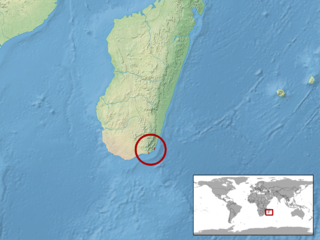
Phelsuma antanosy is a species of day gecko, endemic to the coastal Anosy Region in Madagascar. The species was first discovered in by scientist Raxworthy & Nussbaum in the year 1993. Phelsuma antanosy more commonly known as Antanosy day gecko is one of 45 different species represented in the Phelsuma genus. This specific species of gecko has been placed on the critically endangered list by the IUCN red list since January 28, 2011. Little is known about the Antanosy day gecko because of its recent discovery and the small amount of research done on the species. Although, information about the geographical fragmentation and population location lead to the decision to put the gecko on the critically endangered list.
Pilgerina is a monotypic genus of flowering plants belonging to the family Santalaceae. It only contains one known species, Pilgerina madagascariensis.

Borocera cajani, also known as landibe in Malagasy, is a species of silk-producing lasiocampid moth endemic to Madagascar. It is often confused with the similar Borocera madagascariensis, which has the same Malagasy name. However, B. cajani is the species associated with silk production in highland Madagascar, while B. madagascariensis is found in the coastal portion of the island.
Ephippiandra madagascariensis is a species of flowering plant endemic to Madagascar, where it is known as ambora.
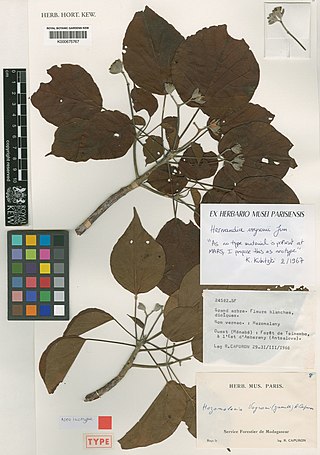
Hernandia voyronii, commonly known as Hazomalany, is a species of plant in the Hernandiaceae family. It is endemic to Madagascar.













